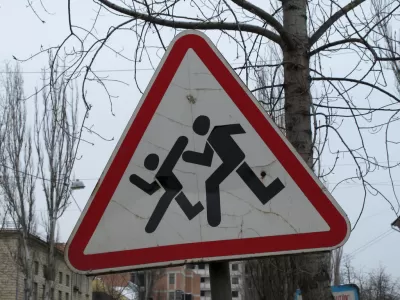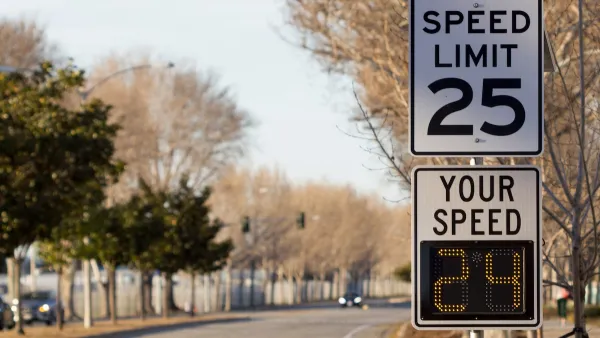A psychological experiment finds that warning signs depicting more movement gain more attention, making drivers navigate more carefully.

Further validating proponents of shared space and traffic calming, "researchers from the University of Michigan and Brigham Young University found that signs that conveyed a greater degree of motion—think a running stick-figure pedestrian, not a strolling one—may raise drivers' perception of risk, which may in turn translate to more caution and attention from behind the wheel."
Cari Romm reports on this study, which exposed subjects to signs of varying dynamism and rated their responses. According to one of the study's co-authors, "From evolutionary psychology we know that humans have developed systems to maximize the chances of detecting potential predators and other dangers. Thus, our attention system has evolved to detect actual movement automatically and quickly."
An opposing theory throws doubt on signs' importance. From the article: "There are others, though, who argue that focusing on the signs themselves—whatever they may depict—are the wrong way to cut down on traffic accidents, which kill around 34,000 people in the U.S. each year, because people may feel like they can rely on the signs and, as a result, don't need to be as aware of their surroundings."
FULL STORY: To Make Roads Safe, Make Them Feel Dangerous

Planetizen Federal Action Tracker
A weekly monitor of how Trump’s orders and actions are impacting planners and planning in America.

Congressman Proposes Bill to Rename DC Metro “Trump Train”
The Make Autorail Great Again Act would withhold federal funding to the system until the Washington Metropolitan Area Transit Authority (WMATA), rebrands as the Washington Metropolitan Authority for Greater Access (WMAGA).

The Simple Legislative Tool Transforming Vacant Downtowns
In California, Michigan and Georgia, an easy win is bringing dollars — and delight — back to city centers.

Albuquerque’s Microtransit: A Planner’s Answer to Food Access Gaps
New microtransit vans in Albuquerque aim to close food access gaps by linking low-income areas to grocery stores, cutting travel times by 30 percent and offering planners a scalable model for equity-focused transit.

This City Will Pay You to Meet Your Neighbors
A North Kansas City grant program offers up to $400 for residents to throw neighborhood block parties.

Commentary: Our Silence Will Not Protect Us
Keeping our heads down and our language inoffensive is not the right response to the times we’re in. Solidarity and courage is.
Urban Design for Planners 1: Software Tools
This six-course series explores essential urban design concepts using open source software and equips planners with the tools they need to participate fully in the urban design process.
Planning for Universal Design
Learn the tools for implementing Universal Design in planning regulations.
Smith Gee Studio
City of Charlotte
City of Camden Redevelopment Agency
City of Astoria
Transportation Research & Education Center (TREC) at Portland State University
US High Speed Rail Association
City of Camden Redevelopment Agency
Municipality of Princeton (NJ)




























